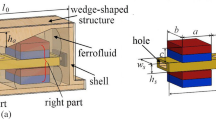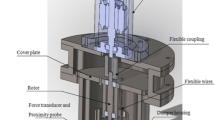Abstract
Background
Flexible aerospace structures present dynamic characteristics of low natural frequency. For a long-term free-floating spacecraft, theses flexible aerospace structures are prone to vibrate due to various excitation. However, it is extremely difficult to eliminate these low-frequency vibrations.
Purpose
The main aim of this paper is to verify the dam** performance of a novel ferrofluid inertial damper with the optimal stiffness in reducing the low-frequency free vibration of structures.
Methods
The ferrofluid inertial damper consists of an inertial mass block, ferrofluids, and two magnetic field sources. The inertial mass block is levitated in two layers of ferrofluid absorbed on magnetic field sources. When the main system vibrates, the ferrofluid can generate a very small restoring force and dam** force between the inertial mass block and the main system. A series of simulations and experiments are used to optimize the restoring force. Furthermore, the influence of the ferrofluid mass on the restoring force is studied. The dam** performance is verified by the free oscillation of a flexible copper plate.
Results
Two sets of geometric parameters whose restoring forces meet the requirement of the optimal stiffness are obtained. Compared to the copper plate damped by itself, the oscillation time of the copper plate with the ferrofluid inertial damper can be reduced by 97.73%.
Conclusion
The inertial mass block has a fast response to external vibrations. The ferrofluid inertial damper has very excellent performance for dam** the free oscillations of a copper plate.
















Similar content being viewed by others
References
Wang KQ, Zhang BN, **ng T (2017) Preliminary integrated analysis for modeling and optimizing space stations at conceptual level. Aerosp Sci Technol 71:420–431. https://doi.org/10.1016/j.ast.2017.09.048
Tang G, Chen B, Zhang M, Guo Q (2020) On-orbit modal identification for vibration suppression of flexible aerospace structure using reaction wheel actuator. Aerosp Sci Technol 107:106250. https://doi.org/10.1016/j.ast.2020.106250
Sales TP, Rade DA, Souza LD (2013) Passive vibration control of flexible spacecraft using shunted piezoelectric transducers. Aerosp Sci Technol 29(1):403–412. https://doi.org/10.1016/j.ast.2013.05.001
Cohen K, Weller T (1994) Passive dam** augmentation for vibration suppression in flexible latticed beam-like space structures. J Sound Vib 175(3):333–346. https://doi.org/10.1006/jsvi.1994.1332
King JA (1977) Method for making loudspeaker with magnetic fluid envelo** the voice coil. US Patent. 4017694.
Lemarquand G, Richoux B, Lemarquand V (2012) Electrodynamic transducer including a dome with a ferrofluid suspension. US Patent. 8131005.
Raj K, Chorney AF (1998) Ferrofluid technology—an overview. Indian J Eng Mater Sci 5(6):372–389
Missiles A (1967) Feasibility study and model development for a ferrofluid viscous damper final report Massachusetts: space and electronics group. 1–84.
Engelmann S, Nethe A, Scholz T, Stahlmann HD (2005) Concept of a new type of electric machines using ferrofluids. J Magn Magn Mater 293(1):685–689. https://doi.org/10.1016/j.jmmm.2005.02.044
Han H, Li S, Guo L, Wu Q (2017) Numerical investigation on suppressing high frequency self-excited noises of armature assembly in a torque motor using ferrofluid. Shock Vib 2017:1–10. https://doi.org/10.1155/2017/4251320
Jun L (2009) Analysis of a porous elastic sheet damper with a magnetic fluid. J Tribol 131(2):021801. https://doi.org/10.1115/1.3075870
Crowley S, Porter R (2012) An analysis of screen arrangements for a tuned liquid damper. J Fluid Struct 34:291–309. https://doi.org/10.1016/j.jfluidstructs.2012.06.001
Yang W, Wei D, Su J, Yang X, Yang Q (2021) Numerical simulation analysis and experimental research on dam** performance of a novel magnetic fluid damper. Adv Mater Sci Eng 2021(3):1–10. https://doi.org/10.1155/2021/6629802
Sudo S, Nakagawa A (2005) Vibration characteristics of the damper element composed of annular magnets and magnetic fluid. Int J Mod Phys B 19(07–09):1520–1526. https://doi.org/10.1142/S0217979205030530
Rosensweig RE (1966) Fluidmagnetic buoyancy. Aiaa J 4(10):1751–1758. https://doi.org/10.2514/3.3773
Rosensweig RE (1966) Buoyancy and stable levitation of a magnetic body immersed in a magnetizable fluid. Nature 210:613–614. https://doi.org/10.1038/210613a0
Wang Z, Bossis G, Volkova O, Bashtovoi V, Krakov M (2003) Active control of rod vibrations using magnetic fluids. J Intel Mat Syst Str 14(2):93–97. https://doi.org/10.1142/9789812777546_0043
Bashtovoi V, Kabachnikov D, Reks A, Suloeva L, Bossis G, Volkova O (2000) Hydrodynamics and energy dissipation in a low-energy magnetic fluid damper. Magnetohydrodynamics 36(3):190–196. https://doi.org/10.1023/A:1004853922147
Yang W, Li D, Feng Z (2013) Hydrodynamics and energy dissipation in a ferrofluid damper. J Vib Control 19(2):183–190. https://doi.org/10.1177/1077546311433441
Yao J, Chang J, Li D, Yang X (2016) The dynamics analysis of a ferrofluid shock absorber. J Magn Magn Mater 402:28–33. https://doi.org/10.1016/j.jmmm.2015.11.040
Bashtovoi VG, Kabachnikov DN, Kolobov AY, Samoylov VB, Vikoulenkov AV (2002) Research of the dynamics of magnetic fluid dynamic absorber. J Magn Magn Mater 252:312–314. https://doi.org/10.1016/S0304-8853(02)00599-1
Bashtovoi VG, Motsar AA, Reks AG (2017) Energy dissipation in a finite volume of magnetic fluid. J Magn Magn Mater 431:245–248. https://doi.org/10.1016/j.jmmm.2016.08.02515
Huang C, Yao J, Zhang T, Chen Y, Jiang H, Li D (2017) Dam** applications of ferrofluids: a review. J Magn 22(1):109–121. https://doi.org/10.4283/JMAG.2017.22.1.109
Yao J, Li D, Chen X, Huang C, Xu D (2019) Dam** performance of a novel ferrofluid dynamic vibration absorber. J Fluid Struct 90:190–204. https://doi.org/10.1016/j.jfluidstructs.2019.06.009
Yamagata Y, Yokotsu K, Ohtsuka K, Sasamori K, Murase S (2000) Vibration tests of 1000 kV gas insulated bushing and influence of connecting leads. IEEJ Trans Power Energ 120(4):603–608. https://doi.org/10.1541/ieejpes1990.120.4_603
Yao J, Chen Y, Li Z, Zhang T, Li D (2016) A novel accelerometer based on the first kind of ferrofluid levitation principle. Smart Mater Struct 25(9):095016. https://doi.org/10.1088/0964-1726/25/9/095016
Bashtovoi VG, Bossis G, Kabachnikov DN, Krakov MS, Volkova O (2002) Modelling of magnetic fluid support. J Magn Magn Mater 252:315–317. https://doi.org/10.1016/S0304-8853(02)00597-8
Lampaert S, Spronck J, Ostayen RV (2018) Load and stiffness of a planar ferrofluid pocket bearing. Proc Inst Mech Eng Part J 232(1):14–25. https://doi.org/10.1177/1350650117739200
Boots AST, Krijgsman LE, Ruiter BJM, Lampaert SGE, Spronck JW (2019) Increasing the load capacity of planar ferrofluid bearings by the addition of ferromagnetic material. Tribol Int 129:46–54. https://doi.org/10.1016/j.triboint.2018.07.048
Funding
This paper is supported by Bei**g Natural Science Foundation (Grant No. 3204042) and National Natural Science Foundation of China (Grant No. 52005283).
Author information
Authors and Affiliations
Contributions
JY contributed to the study conception and design. Data collection and analysis were performed by JY, ZL and XC. The experimental setup and experiments were performed by JY and XC. Material preparation and selection was performed by DL. The revision, error analysis, and repeated experiments of the manuscript were performed by XZ and JY. The first draft of the manuscript was written by JY. All authors read and approved the final manuscript.
Corresponding author
Ethics declarations
Conflict of interest
On behalf of all authors, the corresponding author states that there is no conflict of interest.
Additional information
Publisher's Note
Springer Nature remains neutral with regard to jurisdictional claims in published maps and institutional affiliations.
Rights and permissions
About this article
Cite this article
Yao, J., Zhao, X., Li, Z. et al. Force Optimization and Dam** Performance of a Novel Ferrofluid Inertial Damper Based on the Levitation Principle of Ferrofluids. J. Vib. Eng. Technol. 10, 873–885 (2022). https://doi.org/10.1007/s42417-021-00416-5
Received:
Revised:
Accepted:
Published:
Issue Date:
DOI: https://doi.org/10.1007/s42417-021-00416-5




